Seeing the light through jingling bells
He takes aim and swings his arm back. A loud shout of ‘play’ is called out as an underarm delivery is sent hurtling at the batsman. It
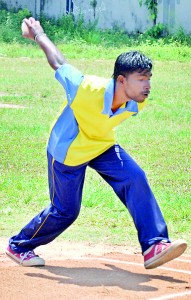
Bowler in full flight
bounces a few times before reaching him. You’d only except the batsman to object, but there is no chagrin as he coolly sweeps the ball down to fine-leg. A loud metal clang is given off and a rattle follows as the ball rolls towards the fielder. What we are witnessing is blind cricket, a format of the game that is slowly raising its head from the dark to reach out to the general public.
It’s a sunny Wednesday morning, and the players are huffing and puffing about at the Railway Grounds Colombo at the first practice session in preparation for the Blind Cricket World Cup, to be held in South Africa this November.
29-year-old Chaminda Pushpakumara Karunaratne — the vice-captain- takes a break to join us in conversation as he unfurls the story of blind cricket in Sri Lanka. He surveys the air in front of him to shake our hands, and as we do, a glowing smile spreads across his face.
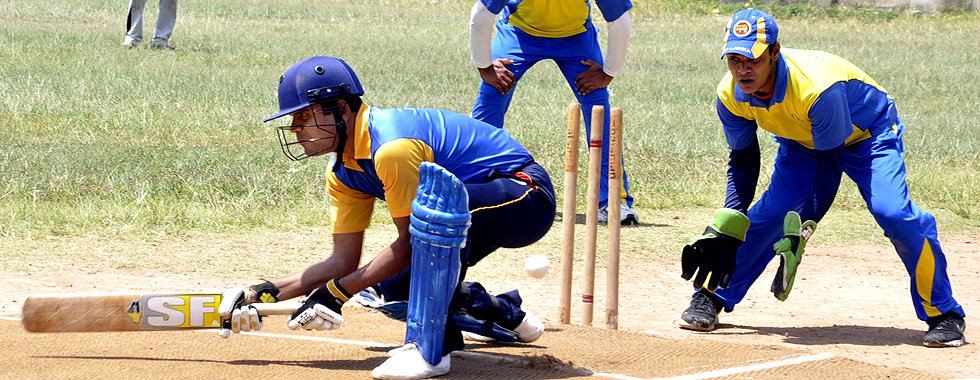
Misses the sweep and is clean bowled
Chaminda tells us that it was in the 1950′s that a group of visually handicapped Sri Lankans from the Ratmalana Blind School -probably having heard of blind cricket exploits around the world- filled a plastic ball with bottle caps and started playing in the school backyard. Thirty years after, a coaching camp conducted by the Australians is held to promote the game in the country.
A further 16 years is what it takes to establish the Sri Lanka Blind Cricketers Association under the auspices of Alex M. Jayawardena, E. M. Sumanapala, S. L. Hettiarachchi, and R. A. Sirisena. Having found new wings, the blind cricketers travel to New Delhi to participate in the first ever Blind Cricket World Cup in 1998.
“Sahenna tharuna kandayamak hitiye”, Chaminda tells us adding that most of the players who represented the World Cup were schoolboys at that time. It was a tough time for the players as they struggled to come to terms with the game. The hearts were heavy with no victories under their belt, but they knew that there was enough cricket in their blood to surge forward.
During the next World Cup held in Chennai, the team recorded their first international victory against England. While a strangely
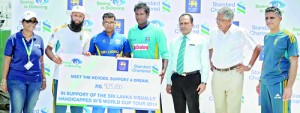
With South African captain Hashim Amla and Lankan skipper Angelo Mathews
mediocre performance was put up at the following World Cup held in Pakistan in 2006, the team bounced back into the headlines by reaching the semi-finals at the inaugural T20 Blind Cricket World Cup held in India, in 2012. The players dub this era as the ‘Golden Years’ of blind cricket in the country, and having trounced the visiting Australians 4-0 in April, the spirits are high amongst the camp to win this year’s World Cup.
“Api hondata padham wela thiyenne. Katta kaagena issarahata yanawa”, they’ve been tossed and turned and thrown into the deep, but there’s strength they draw from these difficulties, says Chaminda.
Chaminda started losing his vision when he was in Grade 9, as the words on the blackboard would slowly fade into black. The next few years would be the toughest in his life as his family struggled unrelentingly to get his vision back. Having lost sight at the playful age of 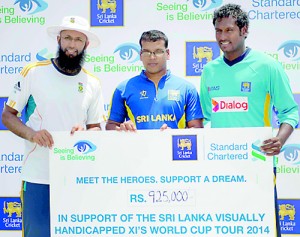 14, Chaminda was even contemplating suicide. He tells us that they spent a fortune on it but had to resort to the Ratmalana Blind School. What was in store for him was a world beyond vision, as he gritted his teeth, learnt Braille and told himself that he would not be dependent of anyone in life.
14, Chaminda was even contemplating suicide. He tells us that they spent a fortune on it but had to resort to the Ratmalana Blind School. What was in store for him was a world beyond vision, as he gritted his teeth, learnt Braille and told himself that he would not be dependent of anyone in life.
When he took up cricket again, the colour that had left his life slowly crept back in.
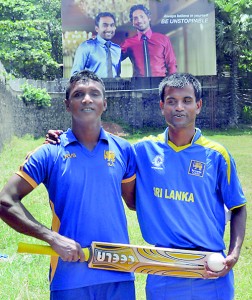
Like Mahela and Sanga
Having joined the Moneragala Blind cricket team, he soon starred the line-up with his all-round abilities. In 2005, having taken 5 wickets for 44 runs against Seeduwa, he came under the radar of the Blind Cricketers Association and has ever since been playing for the country at the top most level.
Today the only platform for blind cricketers to emerge to the top level is through a league tournament sponsored by a leading brand of Ceylon tea.
As we speak, another player is aided off the pitch towards us. “Oya enne Saman Kumara, Australia series ekey palaweni match eka beragaththe meya.” Here comes Saman Kumara, the hero of the opening match on our series against Australia,” says Chaminda.
29-year-old Saman Kumara -hailing from the military- lost complete vision of both eyes during the final battle at Puthukudirippu. He recalls the incident where a mortar rocket had exploded in front of him, as he lay motionless unable to cope with the reality that the world was going murky in front of him. Today Saman Kumara is a vital asset in the team as an aggressive batsman and a strike bowler. He tells us that it is an honour to have fought for the country, and now it’s his turn to play for the country and bring home glory. Father of a 2-year-old daughter, Saman Kumara’s life is beginning to blossom anew.

Pix by Susantha Liyanawatte
We learn that the players have an acute sense of hearing, and the entire game is based on how intently you listen to the ball. The ball -made of plastic, slightly larger than a leather ball and filled with iron ball bearings- makes a distinct to tingle to which the players train their ears to. The sweep shot is the natural favourite, while dabs towards third-man are also used quite effectively.
“We’ve gone through difficult times,” says Chandana Sooriyarachchi, 33, Captain of the Sri Lanka Blind Cricket team. There were times when the captain, vice captain and president of the association had to walk from pillar to post in search of funding for the team.Chandana recalls that sometimes they were even chased away. Although the tides seem to be turning, there’s still much more funding left to rise and awareness left to create.
“We don’t have enough equipment and kits for the team,” says Chandana. The kits they have -donated by a star opening batsman of the National Team- are being washed at least five times a week, while most other equipment is shared between the team.
Spread across all parts of the country, the players also find it hard to slot in hours to practice together. Even when they do come 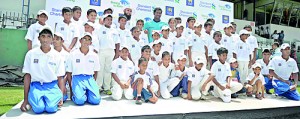 together, there’s always a lack of a proper ground to practice on. “The recent Australian tour was the first time we played on international pitches,” says Chandana.
together, there’s always a lack of a proper ground to practice on. “The recent Australian tour was the first time we played on international pitches,” says Chandana.
Another problem clouding the team is that although they represent Sri Lanka in international tournaments, they have not been registered with Sri Lanka Cricket (SLC). Their only urge is for the SLC to consider registering them under their wings – something that would immensely benefit this talented team in their future exploits. “We are not registered with the SLC and that prevents us from getting proper grounds to train on,” says Chandana. “It also means that we aren’t well funded.”
“We’ve tried on many occasions, but failed to obtain registration,” says U. Priyantha, President of the Sri Lanka Blind Cricketers Association. Having played for the team under the B1 category for well over 10 years, Priyantha knows the bitter fate the cricketers face due to lack of proper funding.
“During our first international series, a lot of players were injured but there was no proper medical team with us to attend to them.” Furthermore, the cricketers do not earn any fee although they represent the country. “We are only able to give them the bus fare and lunch money, nothing more than that. If we had proper recognition, we can approach the public and they will definitely listen to our story.”
Speaking to the Sunday Times, Head of Cricket Operations SLC, Carlton Bernardus stated that although the blind cricket team is not registered under the SLC, they are taking strides to help them out at any opportunity possible. “We are supportive of certain causes, and blind cricket is one of them. We aim to provide infrastructure and resources necessary for practices,” he states.
It wouldn’t really be a Sri Lankan cricket team if not for the world records and keeping up to their able counterparts, the blind cricket team entered the record books with the present highest score of 468 (40 overs), scored against the Australians recently.
For Chaminda, Chandana, Saman Kumara and the rest of the cricketers, this is more than a passion for the game – it’s also about getting over a monotonous life and finding self-confidence in the fact that they are enablers rather than the disabled.
“Our only goal is to bring the World Cup home,” says Chandana. With their determination and more support, the boys just might gift Sri Lanka with a second World Cup this year.
On our way back, the driver asks us “Mahaththaya, mokadda ey amuthu sellama”? What is that strange game? We simply smiled and told him that there’s nothing ‘amuthu’ about it. It’s cricket after all, the game we love and adore.
The road to the World Cup in South Africa was bolstered thanks to funds raised by Sri Lanka Cricket and the visiting South Africa team. SLC and Standard Chartered Bank organised three fundraisers for the blind cricket team, upon which 925,000 Sri Lankan rupees (USD $7300 approx.) was raised. The money had been raised via tickets for a meet-and-greet with both teams, a coaching camp for kids, and an online auction for the chance to meet the players at the ground and receive an autographed ball.


